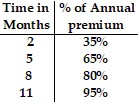Use mathematical induction to prove the following. =
= 
What will be an ideal response?
Answers may vary. One possibility:
Sn:  =
= 
S1: 7 + 5 = 
Sk:  =
= 
Sk+1:  =
= 
1. Basis step: Since  =
=  = 12 = 7 + 5, S1 is true.
= 12 = 7 + 5, S1 is true.
2. Induction step: Let k be any natural number. Assume Sk. Deduce Sk+1. =
= 
[7(k + 1) + 5] +  = [7(k + 1) + 5] +
= [7(k + 1) + 5] + 
 = [7(k + 1) + 5] +
= [7(k + 1) + 5] + 
=  +
+ 
= 
= 
= 
= 
=  .
.
You might also like to view...
Perform the indicated operation. Write the answer in scientific notation.(9 × 102) ÷ (3 × 10-4)
A. 3 × 106 B. 3 × 10-2 C. 6 × 10-2 D. 6 × 106
Find the amount of refund to the insured using this short-term rate schedule.  Annual premium: $834Months in force: 5
Annual premium: $834Months in force: 5
A. $41.70 B. $542.10 C. $166.80 D. $291.90
Use the given conditions to write an equation for the line in slope-intercept form.Slope =  , y-intercept = 2
, y-intercept = 2
A. f(x) =  x - 2
x - 2
B. f(x) =  x +
x + 
C. f(x) = -  x - 2
x - 2
D. f(x) =  x + 2
x + 2
Solve the number problem by finding the value of the unknown number.When twice a number is subtracted from 25, the result is 15.
A. 8 B. 12 C. 4 D. 5